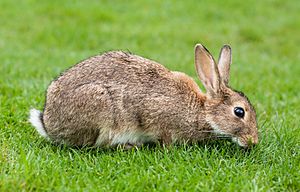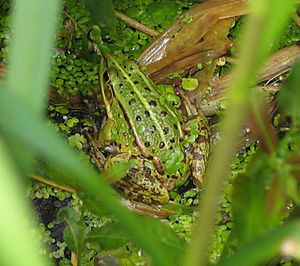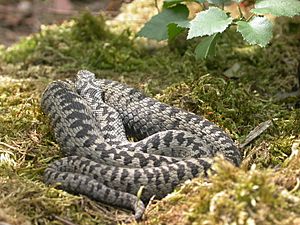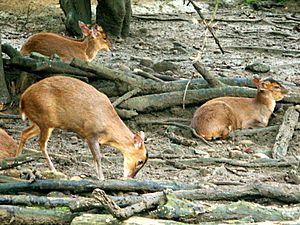Fauna of England facts for kids
The animals of England are a lot like those found in other parts of the British Isles. England is mostly home to small animals. It doesn't have many large mammals, but it has many different kinds of birds, just like other island nations.
England usually has a mild climate, meaning it's not too hot or too cold. It also gets plenty of rain. This makes the country very green and provides lots of food for small animals and those that eat plants.
England's wildlife is different from Scotland's. England has a slightly warmer climate, lower land, and more people. While this can be tough for some animals, it's good for others. England also has many different landscapes, which means it has a wide variety of animals.
Contents
England's Climate and Habitats
Most of England has a temperate oceanic climate. This means it doesn't have extreme hot or cold weather. However, some small areas in the South West are warmer. The North of England is colder and has most of England's mountains and high hills. These areas greatly affect the climate and the animals living there.
Deciduous woodlands (where trees lose their leaves in autumn) are common across England. They provide great homes for many animals. In the northern and upland areas, you'll find coniferous forests (with trees like pines and firs). These forests also help certain types of wildlife.
English animals have learned to live with changing temperatures and conditions. Even though these changes aren't extreme, animals still need to adapt. Animals in England have also had to deal with factories, many people, and intensive farming. But people in England care a lot about protecting their wildlife and countryside.
Some animals have even learned to live in cities and towns. The red fox is very good at this. It's the most successful wild mammal in cities after the brown rat. Other animals, like the common wood pigeon, also do very well in urban areas.
Tiny Creatures: Invertebrates
Molluscs: Snails and Slugs
There are about 220 types of snails and slugs that live in the wild in Britain and England. You can also find 14 types of snails that only live in greenhouses.
Insects: Bugs Galore
England is home to many different kinds of insects. They play a very important role in the environment, from pollinating plants to being food for other animals.
Animals with Backbones: Vertebrates
Amphibians: Frogs and Newts
The amphibians that naturally live in England include the great crested newt, smooth newt, palmate newt, common toad, natterjack toad, common frog, and the pool frog. Some other species have also started living here after being introduced.
Reptiles: Snakes and Lizards
England has four types of native snakes: the European adder, grass snake, barred grass snake, and smooth snake. Some snakes, like the aesculapian snake and dice snakes, have been introduced.
Lizards found in England include slowworms, common lizards, and sand lizards. Some introduced lizards are the European green lizards and the common wall lizard. The common wall lizard was brought from mainland Europe and can be found on the Isle of Wight.
Sea turtles are also seen off the English coast. These include the leatherback sea turtle, green sea turtle, hawksbill, loggerhead sea turtle, and Kemp's ridley. More and more of these turtles are visiting English waters as the seas around Britain get warmer due to climate change.
Some terrapins found in England are the European pond terrapin (introduced from mainland Europe) and the red-eared terrapin (introduced, but not fully established).
Birds: Feathered Friends
England's birds are similar to those in continental Europe. However, because England is an island, it has fewer types of birds that breed here. Some birds, like the crested lark, breed very close by in northern France but haven't settled in Britain.
England and the British Isles are very important homes for many wading birds and shorebirds. England's coastlines are especially important for seabirds. The English coastline is often flatter and sandier than other UK countries. This attracts wading birds, but it also has some rocky areas where birds like puffins can live.
England's mild winters mean that many birds that can't handle very cold conditions come to Britain for the winter. There's a large number of wintering birds arriving from Europe and even as far away as South Africa. About 250 bird species are regularly seen in England, and another 300 appear less often.
Mammals: Furry Creatures

England has few large mammals. It is mostly home to smaller types. England has some non-native deer species that have adapted well to the climate. These deer came from parts of Europe and Southern Siberia. While the Scottish red deer mostly lives in Scotland, smaller deer species, both native and introduced, do well in England. Some, like the muntjac deer, are rarely found in Scotland.
Small Mammals and Insect Eaters
England and the rest of Britain have several types of insect-eating mammals. The hedgehog is probably the most famous. It often visits gardens in towns. Hedgehogs are sometimes hit by cars when crossing busy roads. The mole is also well-known for digging tunnels that can damage garden lawns.
Shrews are also quite common. The smallest, the pygmy shrew, is one of the smallest mammals in the world! England also has several types of bats. The pipistrelle bat is the smallest and most common bat. Rodents are also numerous across Britain and England. The brown rat is by far the most common urban animal after humans. However, some rodents are becoming rare. Losing their homes has caused a drop in the number of dormice and bank voles in Britain.
Grey squirrels, which came from eastern America, have caused a decline in the native red squirrel. This is because they compete for food and homes. Red squirrels are now mostly found in upland and coniferous forest areas of England, mainly in the north, south west, and Isle of Wight. England's climate is very good for lagomorphs (animals like rabbits and hares). The country has rabbits and brown hares, which were brought here by the Romans. Mountain hares, which are native, have now been reintroduced in Derbyshire.
Carnivores: Meat Eaters
England has a variety of carnivores, especially from the weasel family. These range in size from the tiny weasel, stoat, and European polecat (which is rare in England) to the badger and pine marten. The mink and semiaquatic otter have also been introduced. There is a discussion in England about whether badgers should be culled (their numbers reduced) or vaccinated to help stop the spread of bovine tuberculosis (a disease that can affect cows).
Since the wolf and brown bear are no longer found in England, the largest carnivore is the red fox. Foxes are very adaptable and good at finding food, which has allowed them to thrive in cities. Weasels and foxes are very common carnivores in England's countryside and in many towns and cities.
Sea Mammals: Life in the Ocean
The waters off England's coast are a safe place for many sea mammals. These include different types of whales, dolphins, and seals. The grey seal is rare in some parts of the world, but it is found in large numbers along the English coast.








